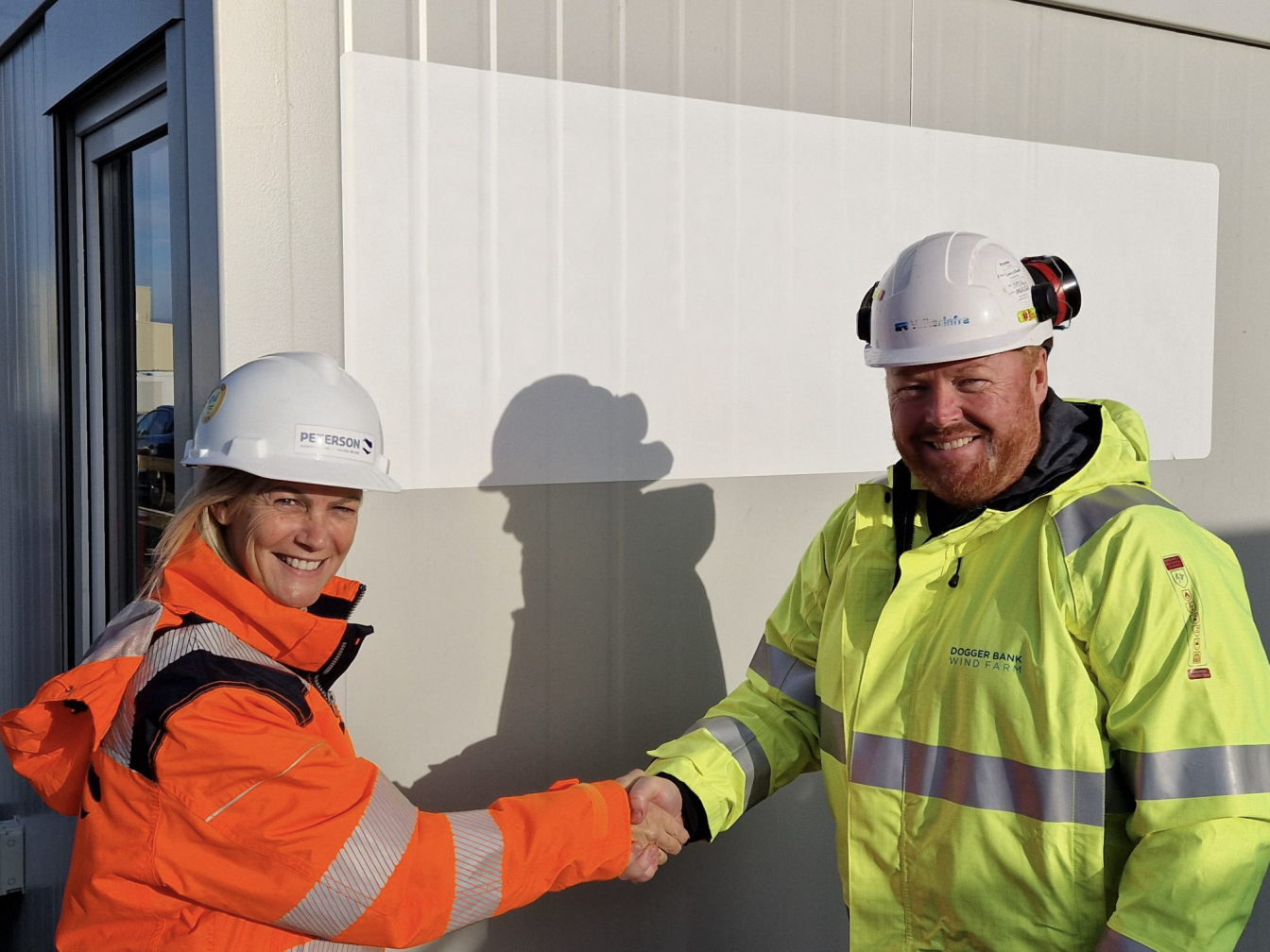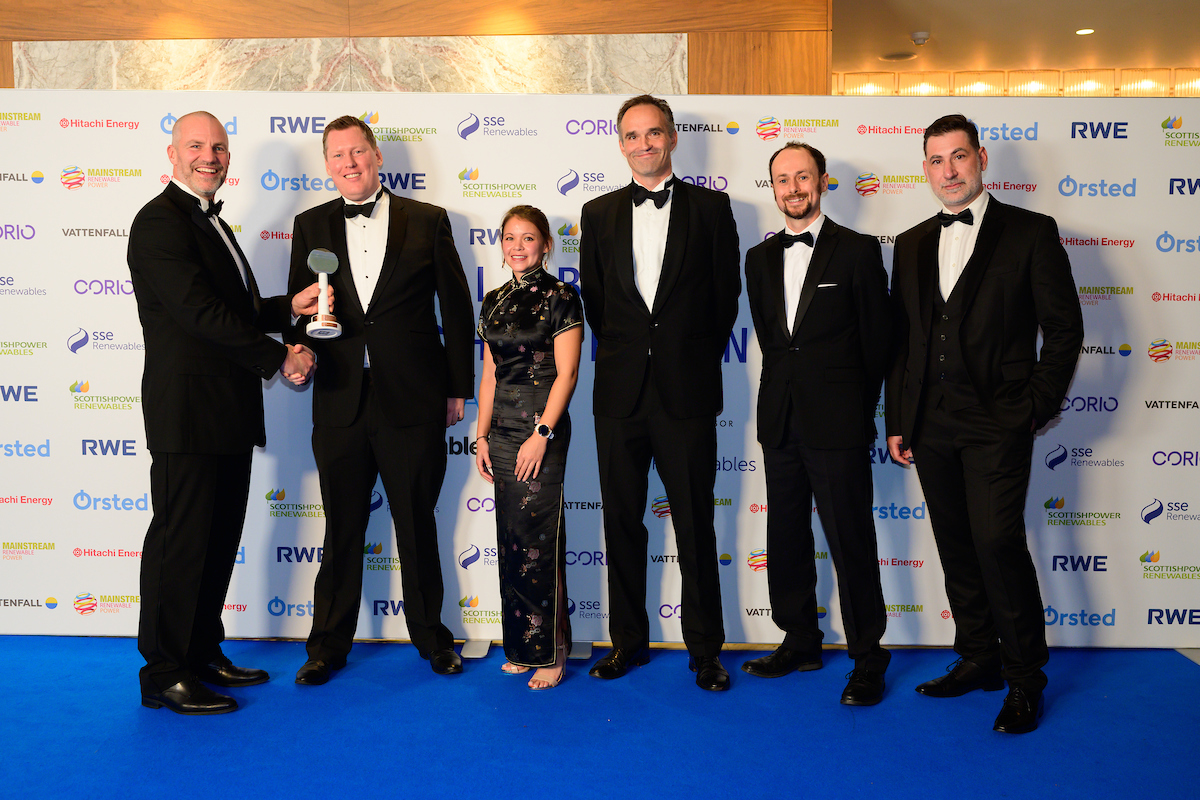9th November 2022 in Construction, Project news, Supply Chain

International energy logistics provider Peterson has been awarded a contract to provide facilities management for shared access to the onshore converter stations for two major offshore wind farms, with the creation of 20 local jobs.
The three-year contract will see Peterson support with the grounds (summer and winter) maintenance, drainage and site security for the shared access areas of a 20-acre converter station construction site adjacent to Wilton International in Teesside on behalf of Dogger Bank C and Sofia offshore wind projects.
Sofia Offshore Wind Farm is 100% owned by RWE and Dogger Bank C, the third phase in the wider Dogger Bank Wind Farm, is owned by SSE Renewables (40%), Equinor (40%) and Vårgrønn (20%). The projects are cooperating closely due to their proximity, including joint contracts for civil engineering and facilities management.
Sandra Hawkins, General Manager for England at Peterson, said:
“We are delighted to have the opportunity to apply our expertise as part of the development of these world-leading wind farms which will deliver significant, long-term benefit to the local area in the years ahead.”
Jason Hendry, Managing Director for England and Renewables Strategy at Peterson, said:
“This contract builds on our existing service offering to the offshore wind sector and aligns with our wider strategy to provide integrated solutions to our customers.
“We look forward to working with all involved to deliver more sustainable energy solutions to households in the UK.”
The contract marks an exciting time for Peterson who are on track to reach carbon neutral status across their global operations by the end of this year.
Supply Chain Manager for Dogger Bank Wind Farm, Robin Banning, said:
“On behalf of Dogger Bank C and Sofia we welcome Peterson’s expertise to our team, bringing local knowledge and capability to the shared site of both project’s converter stations as they continue to take shape.
“This contract will provide around 20 new UK jobs in our supply chain, and will present new opportunities for employment in the north-east of England where a number of our onshore assets will be located, along with our offshore construction hub at Able Seaton .”
27th October 2022 in Community News, Press releases, Project news

The Dogger Bank Wind Farm team walked away with a major award for health, safety and wellbeing following the first ever Global Offshore Wind Awards at a ceremony at the Royal Lancaster Hotel in London this week, for its ‘Safety by Design’ initiative
Organised by RenewableUK, the awards highlight the achievements of innovative people working in the offshore wind industry, as the UK continues its journey to improve Britain’s energy security through an ambition of installing 50 GW of offshore wind by 2030.
Winning the first award of the evening for Offshore Wind Health & Safety and Wellbeing, the team from Dogger Bank Wind Farm, including SSE Renewables, Equinor and foundation designer Wood Thilsted, were commended by the judges for the way they included health and safety as an integral part of project planning and how their approach was the embodiment of best practice in the industry.
The ‘Safety by Design’ initiative used operational experiences, past incidents and industry statistics to improve health and safety through design on Dogger Bank.
Through several design changes of the wind turbines, foundations and service operation vessels (SOVs), this resulted in the following improvements over the project lifetime: 1 million offshore lifts removed, manual handling of 20,000 tons over 1000 kilometres and removal of exposure to a 3-meter fall for 650 days. In addition, the risk of collision between SOVs and the wind turbines has been significantly reduced.
Accepting the award on behalf of Dogger Bank Wind Farm, Project Director Olly Cass said:
“Health and Safety are always the top priorities at Dogger Bank – our motto is ‘if it is not safe, we don’t do it.’ It is fantastic for our H&S colleagues and the wider team to have the quality of their work recognised in this way by the judges and in front of industry peers.”
Andrew Saunders, Dogger Bank Prepare for Operations Manager at Equinor, said:
”It is a real honour to be recognised by the industry for this ‘Safe by Design’ initiative, the result of strong collaboration between project partners and contractors to make a real difference. Taking G+ incident statistics, operational experiences and lessons has led us to eliminate vast amounts of craning and manual handling activities, which will have an incredibly positive impact to the health, safety and wellbeing of our technicians and engineers on a daily basis.”
RenewableUK’s Chief Executive Dan McGrail said:
“The UK is a world leader in offshore wind and it’s right to celebrate what drives our industry forward – growth, innovation, the vibrancy and resilience of our supply chain, our incredible people and the quality of our provisions on health and safety.
Ends
Picture caption: Global Offshore Wind Awards 2022 at Royal Lancaster Hotel
17th October 2022 in Project news

Vårgrønn, a joint venture between Plenitude and HitecVision, has acquired Plenitude’s 20% stake in Dogger Bank Wind Farm.
Olav Hetland, CEO of Vårgrønn, said:
“We are pleased to complete the transaction and appreciate the trust from our shareholders to focus their offshore wind efforts in Northern Europe through the expansion of Vårgrønn. We look forward to a strong cooperation with our experienced partners SSE Renewables and Equinor to construct and operate the world’s largest offshore wind farm. Vårgrønn will actively contribute to the project’s success while Dogger Bank learnings will enrich the skills and experience of the Vårgrønn’s team and make us an even stronger partner in the race for licenses in all our key markets.”
Dogger Bank Wind Farm is being built in the North Sea more than 130km from the Yorkshire coast in three 1.2GW phases known as Dogger Bank A, B and C.
The world-class renewable energy project, which will be capable of powering 6 million UK homes annually on completion, is a joint venture between SSE Renewables (40%), Equinor (40%) and Vårgrønn (20%).
10th October 2022 in Press releases, Project news

Olly Cass has been appointed by SSE Renewables as the new Project Director of Dogger Bank Wind Farm.
The appointment comes following the promotion of the former Project Director, Steve Wilson, to the role of Director of Offshore Capital Projects for SSE Renewables.
Olly Cass said:
“Having been the Finance Director for the past 3 years I’m really looking forward to this new chapter on the project and to continuing to work with such a talented team.
“It’s an incredibly exciting time on the project, with manufacturing ongoing at multiple facilities around the world, the early stages of offshore installation works underway and first power on Dogger Bank A scheduled for July 2023.
“The world’s largest offshore wind farm is a standout project which gives the whole team the ability to make a real difference on some of the biggest issues of the day. Once all three phases are fully operational Dogger Bank Wind Farm will deliver clean renewable power for 6 million UK homes, or about 5% of the UK’s electricity demand.”
Steve Wilson said:
“I am delighted to have been able to appoint Olly as the new Project Director and given his extensive knowledge and experience of Dogger Bank Wind Farm I have no doubt that he has the capabilities needed to lead the construction phase of this industry-leading project.
“I can say from my experience in the role that it is an honour to be involved in both Dogger Bank and in establishing an affordable, resilient and secure source of electricity for UK homes and businesses.”
Dogger Bank Wind Farm is being built in the North Sea more than 130km from the Yorkshire coast in three phases known as Dogger Bank A, B and C. Dogger Bank A and B phases will connect to the national grid near Beverley in East Riding of Yorkshire, while Dogger Bank C will connect to the grid near Redcar, in Teesside.
The world-class renewable energy project, which will be capable of powering 6 million UK homes annually on completion, is a joint venture between SSE Renewables (40%), Equinor (40%) and Eni Plenitude (20%).
Ends
29th September 2022 in Construction, Project news, Supply Chain

Hughes Subsea Services Ltd has signed a contract with Dogger Bank Wind farm to provide vessel, crew and equipment to complete the 2023 internal anode installation campaign across the first phase of the wind farm.
The contract will support up to 60 jobs in the UK supply chain.
Hughes will install the internal cathodic protection systems across the complete 95 wind turbines being installed at Dogger Bank A, using a walk-to-work offshore support vessel.
The system is designed to protect the turbines from corrosion during the wind farm’s 35-year operational lifetime and is being manufactured by South Tyneside specialist, Metec UK.
The work scope is scheduled to commence in Q2 of 2023 and has an expected duration of 2 months.
Ian Hughes, Managing Director at Hughes, said:
“We’re delighted to have been chosen by Dogger Bank Wind Farm for the Anode Installation contract award, we look forward to working with the developers on delivering and building on a successful project.”
Dogger Bank Wind Farm Senior Project Manager, Alan Borland, said:
“Hughes will play an important role in protecting our assets from seawater corrosion during the operational lifetime of the world’s largest offshore wind farm by installing our internal foundation anodes”
“The contract will also support an additional 60 roles in the UK supply chain when this work is underway from Spring 2023.”
Picture caption: Hughes Subsea Services Ltd has signed a contract with Dogger Bank Wind farm to provide vessel, crew and equipment to complete the 2023 internal anode installation campaign across the first phase of the wind farm.
Ends





